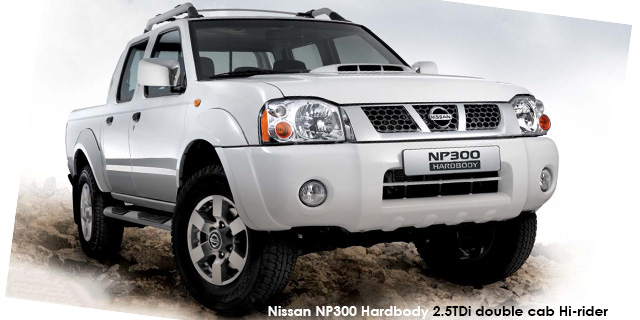Eager to reacquaint ourselves with a Hardbody post-crash-test controversy, we got our hands on a flagship 4x4 double cab...
In November 2018, jaws dropped when Global NCAP released its local crash-test data showing the SA-built Nissan Hardbody had scored zero points for adult occupant protection. Global NCAP concluded the NP300 posed a “high probability of life-threatening injury in a crash”. Public relations disaster aside, we have first-hand experience of the Global NCAP testing procedure – read our technical feature on the crash-test programme in the January 2018 issue – and have no reason to doubt its results.
Leaving crash-testing debates aside for now, we decided to revisit the Hardbody because we last formally tested one in June 2003 (our most recent experience of the bakkie was when one took part in our Tow Car of the Year competition in 2013) and it remains a firm favourite among our readers. A few of our testers also enjoyed recalling experiences with it while making comparisons with newer designs.
Starting with the looks: it’s still relatively fresh, chunky and purposeful. The dead giveaway is its size. When parked next to modern double cabs, the difference is remarkable. This lesser profile aids parking and city driving, but does impact quite a bit on rear space. The aft doors, in particular, are rather small and must be slammed firmly shut. The reason is there are no outlet vents in the rear so there is a brief pressure build-up.
Our test car had an optional rough-road package to enhance its design. At R25 000, it includes a bush bar with headlamp protection, tow bar, snorkel, roll bar, tonneau cover and a touchscreen with sat-nav and a reverse camera. The latter updates the cabin somewhat but everything looks just the way it used to, including the four-spoke leather-bound steering wheel (now sporting an airbag versus that last Hardbody we featured in our road test section). Instead of the old radio/cassette player, the infotainment system incorporates a CD player. There is also a convenient USB port in the glove compartment.
Frustratingly, there isn’t much in the way of storage bins for the driver. Thankfully, Nissan has moulded bottle holders into the postbox-slot front door pockets. These are not ideal for larger water bottles but do hold a wallet and keys. The front seats feel a touch too narrow but provide surprising amounts of side support. Due to the chassis’ sheer height, the seats are mounted low to not restrict headroom. That, unfortunately, leads to a knees-up position for front and rear occupants. Most newer double cabs have successfully addressed this perennial issue that plagued older designs.
The Hardbody also betrays its age by lacking warning buzzers for seatbelt engagements and leaving the headlamps on; the doors don’t automatically lock; and there’s no trip computer. We’re less critical of the outdated-looking slider controls for the air-con; they work very well and require little attention to use on the move.
More impressive than the cabin is Nissan’s 2,5-litre turbodiesel engine, which exhibits little lag and moves through its rev range progressively (although without any great haste). Once up to speed, it maintains momentum without too much effort, but we suspect (without having a trip computer to confirm it) that fuel consumption skyrockets at the national limit.
The steering is still a recirculating-ball setup coupled with hydraulic assistance. This has less direct feel than rack and pinion and that means placing the vehicle on the road requires more effort than in modern bakkies. Where the steering makes sense is in off-roading; on a rough gravel stretch complete with mud and rain, the Nissan was in its element, soaking up the pitted road surface more happily than it would have smooth tar, where the ride is undoubtedly flawed.
A delight is the gearshift quality, which is relatively light but satisfyingly direct. You can even change gears without the clutch using some blipping of the throttle. Low range engages immediately thanks to a manual lever, another refreshingly robust feature. When loaded with 300 kg of cargo, the back dips a bit and the rear shocks exhibit extra movement, but nothing to cause alarm.
Adding fuel to the fire concerning its safety rating, braking performance across our 10 tested emergency stops registered a "poor" rating on our ranking scale, despite the presence of ABS. In fact, it recorded an average stopping time only four percent better than the Hardbody we tested 16 years ago.
TEST SUMMARY
What would you choose at this price point: a new bakkie with an older design; or a second-hand but more modern one? While the answer to this question is a highly subjective one, it’s crucial to take into consideration the Nissan’s confirmed lacklustre safety rating (to be fair, it’s hard – and sometimes impossible – to find evidence of other bakkies’ crash performance; who knows, they might rate as poorly).
While its reliability record is stellar, and ruggedness and impressive off-road ability despite the lack of a diff-lock are guaranteed, Global NCAP’s results and our own braking tests, plus the cramped cockpit and on-road comfort, make us decidedly hesitant to recommend the Hardbody. We’d rather opt for a good second-hand, previous-generation Navara.
ROAD TEST SCORE

|
Original article from Car









